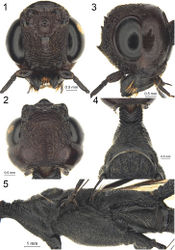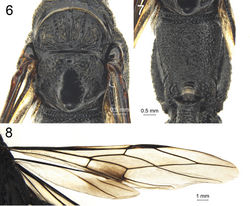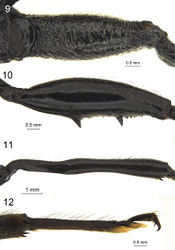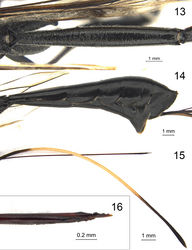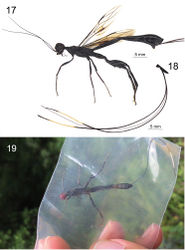Megischus kuafu
| Notice: | This page is derived from the original publication listed below, whose author(s) should always be credited. Further contributors may edit and improve the content of this page and, consequently, need to be credited as well (see page history). Any assessment of factual correctness requires a careful review of the original article as well as of subsequent contributions.
If you are uncertain whether your planned contribution is correct or not, we suggest that you use the associated discussion page instead of editing the page directly. This page should be cited as follows (rationale):
Citation formats to copy and paste
BibTeX: @article{Ge2021ZooKeys1022, RIS/ Endnote: TY - JOUR Wikipedia/ Citizendium: <ref name="Ge2021ZooKeys1022">{{Citation See also the citation download page at the journal. |
Ordo: Hymenoptera
Familia: Stephanidae
Genus: Megischus
Name
Megischus kuafu Ge & Tan sp. nov. – Wikispecies link – ZooBank link – Pensoft Profile
Material examined
Holotype, ♀ (BFU), China: Guizhou, Libo, Maolan National Nature Reserve; Wuyanqiao; 108°6.065'E, 25°17.598'N, 541 m, 26.V.2020, leg. Si-Xun Ge.
Diagnosis
Head completely dark reddish brown (red in alive specimen; Fig. 19), temples slightly bulging behind eyes; ocellar area (Fig. 2) transversely rugose; vertex reticulate-rugose medially, followed by weakly transverse rugae posteriorly almost reaching occipital carina; pronotum (Fig. 4) subparallel anteriorly and with distinct pronotal fold; apical median portion of neck shiny (before protonal fold); medio-anterior pronotum moderately wide (in dorsal view) and strong transverse rugae; scutellum (Fig. 6) almost glabrous and with foveolae laterally; vein 1-M ca 5.9 × as long as vein 1-SR; hind basitarsus densely setose and parallel-sided, ventral length 7.4 × maximum width.
Description
Holotype. Female. Length of body 39.1 mm; forewing 21.3 mm; ovipositor sheath 59 mm.
Head. Antenna with 39 flagellomeres; the first flagellomere slender, length 3.4 × its maximum width, and length of second flagellomere 1.2 × its width; frons coarsely and transversely rugose (Fig. 1); three anterior coronal teeth large and lobe-shaped, both posterior ones smaller and wider; vertex transversely rugose anteriorly and reticulate-rugose medially, followed by coarsely and slightly curved rugosities reaching occipital carina; temple slightly bulging, smooth and shiny (Fig. 2), except for some fine punctures laterally; occipital carina strongly developed and connected to hypostomal carina; hypostomal carina large and without distinct rugae, only some punctures (Fig. 3).
Mesosoma. Neck robust and anteriorly distinctly concave (Fig. 4), with several weak incomplete carina anteriorly and three interrupted and rather strong carina, at lower level than middle part of pronotum postero-dorsally (Fig. 5), and with large smooth and shiny area before pronotal fold; pronotal fold strong, weakly sinuate and below it with rather deep concavity (Fig. 4); middle part of pronotum with nine weak and irregular transverse carinae (as laterally) and with distinct oblique lateral groove; no median carina anteriorly; middle part of pronotum weakly differentiated from posterior part (Fig. 5), and latero-posteriorly rather weakly convex; posterior part of pronotum generally with rather sparse setosity, latero-ventrally densely setose but dorso-posteriorly glabrous, with several coarse punctures and latero-posteriorly with some crenulae; propleuron coriaceous and setose; prosternum densely foveolate, foveolae circular and setose; convex part of mesopleuron strongly foveolate and with dense short whitish setosity (Fig. 5); mesosternum largely smooth (except some fine punctures); scutellum smooth and with foveolae laterally (Fig. 6); propodeum dorsally almost glabrous (Fig. 7), completely with shallow, circular foveolae, most foveolae are separated and some of them coalescent. Wings. Fore wing: wing membrane largely subhyaline (Fig. 8), and surface evenly bristly; vein M+CU1 with four short, erect, equidistant spiny setae; vein 1-M 5.9 × as long as vein 1-SR and 0.8 × vein m-cu; vein 2-SR 0.9 × as long as vein r; vein r ends 0.5 × length of pterostigma behind the level of apex of pterostigma; vein 1-SR 1.1 × as long as parastigmal vein; vein 3-CU1 distinct and curved apically.
Legs. Hind coxa rather strong, annular, largely transversely striate, with long whitish setosity strongly inclined towards (Fig. 9); hind femur robust, with scattered punctures and largely smooth and shiny interspaces (Fig. 10), hind femur ventrally with two large teeth and ten minute teeth in between and one small tooth behind large posterior tooth; hind tibia distinctly curved basally (Fig. 11), elongate and 1.2 × longer than hind femur, densely setose and mostly sparsely punctate, basal narrow part of hind tibia 0.5 × as wide as widest part, lateral view of hind tibia below depression nearly parallel-sided and slender, inner side rather convex basally, densely setose; hind basitarsus slender and parallel-sided, bristly setose ventrally, ventral length 7.4 × its maximum width (Fig. 12). Metasoma. Tergite I transversely striate-rugose (Fig. 13), ca 6.9 × as long as its maximum width and 10.4 × its apical width, 1.9 × as tergite II and 0.7 × as remainder of metasoma; basal 0.1 of tergite II rugose, remainder smooth and glabrous; remainder of tergites (Fig. 14) shiny and with sparse and short setae (except tergite VII densely setose medially); pygidial area coriaceous, medially moderately convex and distinctly punctate medially and anteriorly, with long straight setae; length of ovipositor sheath ca 1.5 × as long as body and ca 2.8 × as long as forewing, length of subapical whitish band (Fig. 15) twice as long as dark apical part. Ovipositor tip laterally compressed, with minute teeth apically (Fig. 16). Colour. Mostly black; mesosoma, metasoma, antennae, and hind legs black or blackish; head dark reddish brown; tergite II brownish bilaterally; wing membrane light brownish, hyaline, except most of hind portion of first subdiscal cell and apical part of hind wing brown; veins and pterostigma brown or dark brown; fore and middle legs dark brown (except for coxae black); ovipositor sheath largely black and with whitish subapical band.
Male. Unknown.
Etymology
The species name is derived from the name of a giant chasing the sun in Chinese mythology, as an analogy of its exclusively large size and a dark reddish-brown head.
Distribution
China (Guizhou).
Biology
Collected in May. Host is unknown.
Note
The description is based on the pinned holotype. The colour of the head changed from bright red into dark reddish brown after it died (Fig. 19). The genus Megischus contains the largest known stephanids and some of them can be up to 35 mm (Binoy et al. 2020[1]). Although the size of parasitoids varies among specimens of the same species due to the nutritional conditions of the host and other factors, the body length of 39 mm makes M. kuafu the largest known Megischus specimen, and also the largest Stephanidae. The large size and general colour pattern more or less resemble M. ducaloides van Achterberg, 2004, but it can be easily distinguished from it by the distinct pronotal fold and the rounded shape of the posterior part of the pronotum. The new species runs to M. ptosimae in the key to Chinese species by Hong et al. (2011)[2] in having the temple slightly convex behind eye, a distinct pronotal fold and cavity below it, and vein 1-M of fore wing ca 5.5 × as long as vein 1-SR. However, the new species differs from M. ptosimae in lacking a pale yellowish malar space, vein 1-M 0.8 × as long as vein m-cu of the fore wing, less sculptured scutellum, posterior half of the hind tibia weakly concave ventrally and the hind basitarsus ca 7.4 × as long as wide. This new species runs to M. rubripes (Kieffer, 1916) in the key to Old World Megischus by van Achterberg (2002)[3], but it differs from M. rubripes in having a more irregular sculpture of the vertex, a large, smooth, and shiny concavity before the pronotal fold, blackish hind tibia and hind basitarsus and tergite I ca 6.9 × as long as its maximum width.
Original Description
- Ge, S; Shi, H; Ren, L; Tan, J; 2021: Description of a new species of Megischus Brullé (Hymenoptera, Stephanidae), with a key to the species from China ZooKeys, 1022: 65-77. doi
Images
|
Other References
- ↑ Binoy C, van Achterberg C, Girish Kumar P, Santhoshi S, Sheela S (2020) A review of Stephanidae (Hymenoptera: Stephanoidea) from India, with the description of five new species.Zootaxa4838(1): 1–51. https://doi.org/10.11646/zootaxa.4838.1.1
- ↑ Hong C, van Achterberg C, Xu Z (2011) A revision of the Chinese Stephanidae (Hymenoptera, Stephanoidea).ZooKeys110: 1–108. https://doi.org/10.3897/zookeys.110.918
- ↑ van Achterberg C (2002) A revision of the Old World species of Megischus Brullé, Stephanus Jurine and Pseudomegischus gen. nov., with a key to the genera of the family Stephanidae (Hymenoptera: Stephanoidea).Zoologische Verhandelingen Leiden339: 1–206.
